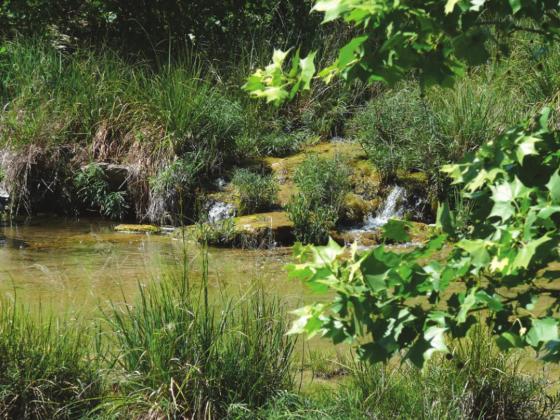Riparian areas or riparian zones are defined as the land area along the edge of the water up to and including the flood zone. And in this context, the flood zone includes that area that generally floods every year or two, but not up as high as the “100-year flood plain.”
The condition of the riparian areas is vitally important to all wildlife in and near the water, as well as the quality and quantity of water for our own use. Life as we know it depends on healthy riparian ecosystems.
So, what constitutes a healthy riparian area, as opposed to one that is unhealthy? The simple answer is vegetation. A healthy riparian area will contain an abundance of several types of vegetation ranging from small sedges and grasses along the water’s edge to larger grasses and shrubs and finally deeply-rooted large trees.
The important functions of this vegetation are to hold the soil in place, even during a flood, to reduce erosion, to catch and hold sediment washing down from upstream, and to maintain the soil in a healthy, porous condition allowing for deep infiltration of water into the aquifer which maintains the base flow of the stream.
Other functions of this vegetation are to shade the stream thus keeping the water temperature at healthy levels for fish and other aquatic species, to provide habitat for numerous birds, butterflies, dragonflies, and larger animals and forage for grazers and browsers.
Riparian vegetation is generally classified as “colonizers” or “stabilizers.” The former are generally small plants that can become established in damaged areas and grow roots quickly to help hold the soil in place until stabilizer plants that are better able to hold the soil permanently can get established.
Stabilizer herbaceous plants include larger sedges such as Emory sedge and sawgrass, large grasses such as switchgrass, eastern gamagrass, Lindheimer muhly, bushy bluestem, and forbs such as American water-willow. Woody stabilizer plants include buttonbush, bald cypress, black willow, baccharis and sycamore.
While all of these species have different abilities to stabilize the soil, it has been shown that combinations of several different types together provide far more stability than any one species alone. Think of the root systems of these stabilizers as the “rebar” holding together the riparian soil.
The porous riparian soil holds huge quantities of water which is what provides much of the base flow to the creek in dry times, so the condition of this soil is critical to stream flow. Soil that is stripped of its vegetation by mowing or grazing or that is compacted by animals or vehicles will contain much less moisture.
Unfortunately, we humans believe that we should be able to sit on our porches above the creek and look down and see the water, or to have a large mowed lawn next to the water’s edge where we can sit and fish or swim or just enjoy the bubbling brook. Or we have cattle and the creek is their only water source so they spend a lot of time along the banks. While these activities may be logical and just part of our human nature, they are counterproductive to a healthy riparian ecosystem.
Healthy riparian areas usually have the densest vegetation, from big trees to an abundance of shrubs, forbs and grasses. Put simply, you can’t see the water from a distance in most healthy riparian areas of small streams, because it is obscured by vegetation. If that vegetation has been removed, either by humans or their animals, that stretch of the stream is no longer healthy and will be subject to greater erosion in the future.
Other than areas where native vegetation has been removed, the next greatest threat to a healthy riparian ecosystem is invasive exotic plants which crowd out mixtures of native species and replace them with a monoculture of exotic plants. The two most common are giant reed (Arundo donax) which can grow 20 feet tall and crowd out everything else and is common along the Guadalupe and its feeder creeks, and Salt cedar (Tamarisk ramosissima) which is more common in our western rivers. Other problem exotics are Chinese tallow, Chinaberry and vitex.
If you are fortunate enough to have property on a creek, I urge you to call the Nueces River Authority at 800-278- 6810 and ask for a copy of the booklet “Your Remarkable Riparian.” You will be glad you did, and your riparian area will be better for it.
Until next time…
Jim Stanley is a Texas Master Naturalist and the author of the books “Hill Country Ecology,” “Hill Country Landowner’s Guide” and “A Beginner’s Handbook for Rural Texas Landowners.” He can be reached at <jstmn@ktc.com>. Previous columns can be seen at <www.hillcountrynaturalist.org>.


